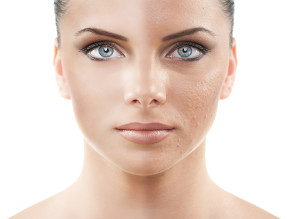In this series about chemical peels the first two was general information about chemical peels and adverse affects of having a peel. Over the next couple of blogs I will go into the different chemical peels and what they treat. This week it is about the Glycolic Acid which is the smallest type of alpha-hydroxy-acid. This colorless, odorless, and hygroscopic crystalline solid is highly soluble in water. It is found naturally in sugar cane and grapes.
Professional concentrations of 20 to 70% or at-home kits in lower concentrations between 10 and 20%. In addition to concentration, pH also plays a large part in determining the potency of the acid solution. Physician-strength peels can have a pH as low as 0.6 (strong enough to completely keratolyze the epidermis), while acidities for home peels can be as high as 4.5. You will also find Glycolic Acid in many skincare products, normally labeled as AHA and is mainly used for anti-aging, pigmenation reduction and even for acne treatment but I am not in favor of everyday use of skincare with AHA’s as it can over exfoliate the skin and cause other problems especially dehydration.
How Glycolic Acid Works?
Once applied, glycolic acid reacts with the upper layer of the epidermis, weakening the binding properties of the lipids that hold the dead skin cells together. This allows the stratum corneum to be exfoliated, exposing live skin cells. has many applications in skin care products as a natural skin exfoliant. Its capability to penetrate the skin is key when allowing old, sun-damaged skin cells to shed, renewing the skin’s texture and vitality.
By loosening the glue-like substance that keeps dead skin cells on the surface of the skin, glycolic acid can help you gain back that healthy glow. This exfoliation process may help reduce wrinkles and hyper pigmentation, and promote an overall rejuvenated appearance.
Through stimulating new cell and collagen production, fine lines and shallow acne scars are reduced, improving the skin’s tone and texture. As well as promoting new skin cell growth, glycolic peel can also help unclog pores -aiding those with acne prone skin.
Skin Condition Glycolic Acid Treats
Glycolic acid has long been heralded as a cure-all for dull, lack luster skin. This acid boasts the ability to refine and renew the skin, improve the skin’s appearance and texture. It may reduce wrinkles, acne scarring, hyper-pigmentation and improve many other skin conditions, including actinic keratosis, hyperkeratosis, and seborrheic keratosis.
Fitzpatrick Skin Types that suites Glycolic Acid Peels
May be performed on Fitzpatrick skin types I to III and with caution on skin type IV
Contraindications to having a peel.
It is generally recommended that pregnant and nursing women not receive peels since there are no studies, about the effects of peels on fetuses or nursing babies. You cannot get a peel if you are on Accutane or any other prescription Vitamin A and you will have to wait at less than 6 months after stoping to use these prescription. If you are prone to cold sores, a peel can actually bring on an outbreak. You should take anti-viral medication before the day of and the day after your treatment. Also if you have a tendency to scar, are taking antibiotics, have cancer or an autoimmune disease, or have an open sore you cannot get a chemical peel.
Professional Treatment Plan
You also generally do a peel every 3 to 4 weeks to allow the skin to fully recover and repair between each peel. After your skin adjusts to the peel, you therapist can either start layering peels to make them stronger (applying one layer, waiting 5 minutes, and then applying a second layer) or start using peels with stronger concentrations.
What to expect After you have a Professional Peel:
After you get a peel, your skin will be red for a few hours, maybe even the whole day. To ease this redness, you can use cooling products (i.e. aloe vera gel) or cooling masks or simply wrap your skin in a cold towel. What I like to do is stick my face in a cool-mist humidifier.
Your skin will also be a bit drier and you may physically flake or peel in certain places. If you do flake, don’t pick at it! Let your skin peel naturally or you risk damaging it. You can help your skin a bit by applying moisturizer more frequently throughout the day and drinking extra water. There is pretty little down time associated with glycolic. Most people don’t peel at all unless the peel is very, very strong.
Always be patient with your skin. Your skin did not get bad overnight, so it’s not going to get 100% better overnight either. You will need to get several chemical peels before you start seeing your desired results.
I have found that many people benefit from Glycolic Acid Peels but unfortunately my skin reacts very badly to this type of AHA. What is your experience of Glycolic peels and skincare leave a comment below.








